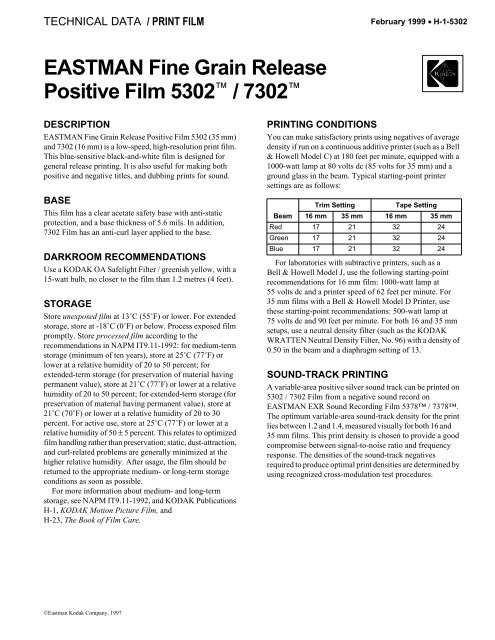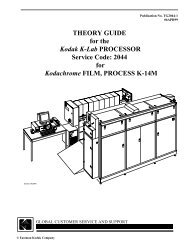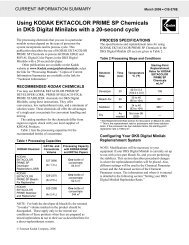EASTMAN Fine Grain Release Positive Film 5302™ / 7302™ - 125px
EASTMAN Fine Grain Release Positive Film 5302™ / 7302™ - 125px
EASTMAN Fine Grain Release Positive Film 5302™ / 7302™ - 125px
Create successful ePaper yourself
Turn your PDF publications into a flip-book with our unique Google optimized e-Paper software.
TECHNICAL DATA / PRINT FILM February 1999 • H-1-5302<br />
<strong>EASTMAN</strong> <strong>Fine</strong> <strong>Grain</strong> <strong>Release</strong><br />
<strong>Positive</strong> <strong>Film</strong> 5302 / 7302 <br />
DESCRIPTION<br />
<strong>EASTMAN</strong> <strong>Fine</strong> <strong>Grain</strong> <strong>Release</strong> <strong>Positive</strong> <strong>Film</strong> 5302 (35 mm)<br />
and 7302 (16 mm) is a low-speed, high-resolution print film.<br />
This blue-sensitive black-and-white film is designed for<br />
general release printing. It is also useful for making both<br />
positive and negative titles, and dubbing prints for sound.<br />
BASE<br />
This film has a clear acetate safety base with anti-static<br />
protection, and a base thickness of 5.6 mils. In addition,<br />
7302 <strong>Film</strong> has an anti-curl layer applied to the base.<br />
DARKROOM RECOMMENDATIONS<br />
Use a KODAK OA Safelight Filter / greenish yellow, with a<br />
15-watt bulb, no closer to the film than 1.2 metres (4 feet).<br />
STORAGE<br />
Store unexposed film at 13˚C (55˚F) or lower. For extended<br />
storage, store at -18˚C (0˚F) or below. Process exposed film<br />
promptly. Store processed film according to the<br />
recommendations in NAPM IT9.11-1992: for medium-term<br />
storage (minimum of ten years), store at 25˚C (77˚F) or<br />
lower at a relative humidity of 20 to 50 percent; for<br />
extended-term storage (for preservation of material having<br />
permanent value), store at 21˚C (77˚F) or lower at a relative<br />
humidity of 20 to 50 percent; for extended-term storage (for<br />
preservation of material having permanent value), store at<br />
21˚C (70˚F) or lower at a relative humidity of 20 to 30<br />
percent. For active use, store at 25˚C (77˚F) or lower at a<br />
relative humidity of 50 ± 5 percent. This relates to optimized<br />
film handling rather than preservation; static, dust-attraction,<br />
and curl-related problems are generally minimized at the<br />
higher relative humidity. After usage, the film should be<br />
returned to the appropriate medium- or long-term storage<br />
conditions as soon as possible.<br />
For more information about medium- and long-term<br />
storage, see NAPM IT9.11-1992, and KODAK Publications<br />
H-1, KODAK Motion Picture <strong>Film</strong>, and<br />
H-23, The Book of <strong>Film</strong> Care.<br />
©Eastman Kodak Company, 1997<br />
A-009 Month 1996<br />
PRINTING CONDITIONS<br />
You can make satisfactory prints using negatives of average<br />
density if run on a continuous additive printer (such as a Bell<br />
& Howell Model C) at 180 feet per minute, equipped with a<br />
1000-watt lamp at 80 volts dc (85 volts for 35 mm) and a<br />
ground glass in the beam. Typical starting-point printer<br />
settings are as follows:<br />
Trim Setting Tape Setting<br />
Beam 16 mm 35 mm 16 mm 35 mm<br />
Red 17 21 32 24<br />
Green 17 21 32 24<br />
Blue 17 21 32 24<br />
For laboratories with subtractive printers, such as a<br />
Bell & Howell Model J, use the following starting-point<br />
recommendations for 16 mm film: 1000-watt lamp at<br />
55 volts dc and a printer speed of 62 feet per minute. For<br />
35 mm films with a Bell & Howell Model D Printer, use<br />
these starting-point recommendations: 500-watt lamp at<br />
75 volts dc and 90 feet per minute. For both 16 and 35 mm<br />
setups, use a neutral density filter (such as the KODAK<br />
WRATTEN Neutral Density Filter, No. 96) with a density of<br />
0.50 in the beam and a diaphragm setting of 13.<br />
SOUND-TRACK PRINTING<br />
A variable-area positive silver sound track can be printed on<br />
5302 / 7302 <strong>Film</strong> from a negative sound record on<br />
<strong>EASTMAN</strong> EXR Sound Recording <strong>Film</strong> 5378 / 7378.<br />
The optimum variable-area sound-track density for the print<br />
lies between 1.2 and 1.4, measured visually for both 16 and<br />
35 mm films. This print density is chosen to provide a good<br />
compromise between signal-to-noise ratio and frequency<br />
response. The densities of the sound-track negatives<br />
required to produce optimal print densities are determined by<br />
using recognized cross-modulation test procedures.
PROCESSING<br />
Use the following process recommendations as starting<br />
points for a typical continuous-immersion processor using<br />
formulas presented in KODAK Publication No. H-24.15,<br />
Manual for Processing <strong>EASTMAN</strong> Motion Picture <strong>Film</strong>s,<br />
Module 15. The processing times may require modification<br />
for a particular machine.<br />
Processing<br />
Step<br />
KODAK<br />
Developer D-97*<br />
Stop Rinse‡<br />
KODAK<br />
Fixing Bath F-5*<br />
Wash<br />
(countercurrent)<br />
Dry<br />
Temperature<br />
˚C (˚F)<br />
21 ± 0.3<br />
(70 ± 0.5)<br />
21 ± 1<br />
(70 ± 2)<br />
Time<br />
(min:sec)<br />
Replenishment<br />
Rate<br />
(mL per 100 ft)<br />
35 mm 16 mm<br />
* Agitation in the developer and in the fixing bath should be by<br />
recirculation through submerged spray jets that impinge on the film<br />
strands.<br />
† Develop to the recommended control gamma of 2.4 to 2.6 Status M<br />
Densitometry (Blue).<br />
‡ Fixer-laden water overflow from the first wash tank (pH approximately<br />
6.0).<br />
21 ± 1<br />
(70 ± 2)<br />
21 ± 1<br />
(70 ± 2)<br />
35<br />
(95)<br />
Notice: Observe precautionary information on product<br />
labels and on Material Safety Data Sheets.<br />
†<br />
650<br />
(D-97R)<br />
325<br />
(D-97R)<br />
0:50 12,000 6,000<br />
6:00 600 300<br />
10:00 12,000 6,000<br />
§ Drying depends on many factors such as air temperature, relative<br />
humidity (RH), volume, rate and distribution of the air flow, final<br />
squeegeeing, etc. In a conventional convectional-type drying cabinet<br />
with air at about 35˚F (95˚C) and 40- to 50-percent RH, drying will take<br />
15 to 20 minutes. In an impingement-type drying cabinet, however, with<br />
a higher temperature and lower RH, drying time is greatly reduced. WIth<br />
either type of dryer, the film should be dry without tackiness 1 ⁄2 to 2 ⁄3 of<br />
the way through. Upon cooling to room temperature after leaving the<br />
dryer, the film should be at equilibrium with the room air at approximately<br />
50-percent RH.<br />
§<br />
— —<br />
LUBRICATION<br />
All films destined for projection require some lubrication to<br />
prevent problems during early projection life. Edge waxing<br />
with a paraffin wax solvent solution provides a simple,<br />
inexpensive, and adequate lubrication for 35 and 70 mm<br />
projection prints. For 8 and 16 mm prints, an overall<br />
lubricant may be required.<br />
IMAGE STRUCTURE<br />
The modulation-transfer curves, the diffuse rms granularity,<br />
and the resolving power data were generated from samples<br />
of 5302 <strong>Film</strong> exposed with tungsten light and processed as<br />
recommended in KODAK Developer D-97 at 21˚C (70˚F) to<br />
the recommended control gamma. For more information on<br />
image-structure characteristics, see KODAK Publication<br />
No. H-1, KODAK Motion Picture <strong>Film</strong>.<br />
Diffuse RMS Granularity* 8<br />
Resolving<br />
Power†<br />
TOC 1.6:1<br />
TOC 1000:1<br />
63 lines/mm<br />
125 lines/mm<br />
* Read at a net diffuse visual density of 1.0, using a 48micrometre<br />
aperture.<br />
† Determined according to a method similar to the one described<br />
in ISO 6328-1982, Photography—Photographic Materials—<br />
Determination of ISO Resolving Power.<br />
2 <strong>EASTMAN</strong> <strong>Fine</strong> <strong>Grain</strong> <strong>Release</strong> <strong>Positive</strong> <strong>Film</strong> 5302 / 7302 • H-1-5302
DENSITY<br />
LOG SENSITIVITY*<br />
4.0<br />
3.0<br />
2.0<br />
1.0<br />
GAMMA<br />
0.0<br />
1.0<br />
1.0<br />
0.0<br />
_<br />
1.0<br />
_<br />
2.0<br />
_<br />
3.0<br />
250<br />
2.8<br />
2.6<br />
2.4<br />
2.2<br />
2.0<br />
Time-<br />
Gamma<br />
Time-Fog<br />
2 4 6 8 10<br />
DEVELOPMENT TIME<br />
(Minutes)<br />
Characteristic Curves<br />
Exposure: Tungsten<br />
Process: KOKAK Developer<br />
D-97, at 21 C (70 F)<br />
Densitometry: Diffuse<br />
Visual<br />
3.4<br />
3.2<br />
3.0<br />
300<br />
NET<br />
FOG<br />
0.10<br />
0.00<br />
3 1/2 min.<br />
2 min.<br />
0.0<br />
1.0<br />
2.0<br />
LOG EXPOSURE (lux-seconds)<br />
7 min.<br />
5 min.<br />
Spectral-Sensitivity Curves y<br />
D=0.3 Above<br />
gross fog<br />
D=1.0 Above<br />
gross fog<br />
350<br />
400 450 500 550 600<br />
WAVELENGTH (nm)<br />
9 min.<br />
3.0<br />
F010_0023AC<br />
Effective Exposure:<br />
1.4 seconds<br />
Process: KODAK Developer<br />
D-97 at 21 C(70 F) to<br />
recommended control<br />
gamma<br />
Densitometry: Diffuse Visual<br />
650<br />
700 750<br />
2<br />
*Sensitivity = reciprocal of exposure (ergs/cm ) required<br />
to produce specified density<br />
F010_0024AC<br />
Modulation-Transfer Curve<br />
1 2 3 4 5 10 20 50 100 200 600<br />
SPATIAL FREQUENCY (cycle/mm)<br />
Notice: While the data presented are typical of production<br />
coatings, they do not represent standards which must be met<br />
by Kodak. Varying storage, exposure, and processing<br />
conditions will affect results. The company reserves the right<br />
to change and improve product characteristics at any time.<br />
These photographic modulation-transfer values were<br />
determined by using a method similar to the one described in<br />
ANSI Standard PH2.39-1977(R1990). The film was<br />
exposed with the specified illuminant to spatially varying<br />
sinusoidal test patterns having an aerial image modulation of<br />
a nominal 35 percent at the image plane, with processing as<br />
indicated. In most cases, the photographic modulationtransfer<br />
values are influenced by development-adjacency<br />
effects and are not equivalent to the true optical modulationtransfer<br />
curve of the emulsion layer in the particular<br />
photographic product.<br />
<strong>EASTMAN</strong> <strong>Fine</strong> <strong>Grain</strong> <strong>Release</strong> <strong>Positive</strong> <strong>Film</strong> 5302 / 7302 • H-1-5302 3<br />
RESPONSE (%)<br />
200<br />
100<br />
70<br />
50<br />
30<br />
20<br />
10<br />
7<br />
5<br />
3<br />
2<br />
1<br />
Effective Exposure:<br />
1.4 seconds<br />
Process: KODAK Developer<br />
D-97 at 21 C(70 F) to<br />
recommended control<br />
gamma<br />
Densitometry: Diffuse Visual<br />
F010_0025AC
<strong>EASTMAN</strong> <strong>Fine</strong> <strong>Grain</strong> <strong>Release</strong> <strong>Positive</strong> <strong>Film</strong> 5302 / 7302<br />
KODAK LOCATIONS<br />
FOR DIRECT ORDERING IN THE UNITED STATES:<br />
1-800-621-FILM<br />
ATLANTA, GEORGIA<br />
4 Concourse Parkway<br />
Suite 300<br />
Atlanta, Georgia 30328-6105<br />
Information: 800-800-8398<br />
CHICAGO, ILLINOIS<br />
815 West Van Buren, Suite 320<br />
Chicago, Illinois 60607<br />
Information: 312-492-1423<br />
DALLAS, TEXAS<br />
11337 Indian Trail<br />
Dallas, Texas 75229<br />
Information: 972-481-1170<br />
312-492-1423<br />
HOLLYWOOD, CALIFORNIA<br />
6700 Santa Monica Boulevard<br />
P. O. Box 38939<br />
Hollywood, California 90038-1203<br />
Information: 323-464-6131<br />
NEW YORK, NEW YORK<br />
360 West 31st Street<br />
New York, New York 10001-2727<br />
Information: 212-631-3450<br />
LATIN AMERICAN REGION<br />
8600 NW 17th Street, Suite 200<br />
Miami, Florida 33126<br />
Information: 305-507-5656<br />
<strong>EASTMAN</strong> <strong>Fine</strong> <strong>Grain</strong> <strong>Release</strong> <strong>Positive</strong><br />
<strong>Film</strong> 5302 / 7302<br />
KODAK Publication No. H-1-5302<br />
CAT 831 2100<br />
Professional<br />
Motion Imaging<br />
Kodak, Eastman, 5302, 7302, Wrratten, 5373, 7373,<br />
and D-97 are trademarks<br />
FOR DIRECT ORDERING IN CANADA:<br />
1-800-621-FILM<br />
MONTREAL, CANADA<br />
Kodak Canada Inc.<br />
4 Place du Commerce, Suite 100<br />
1le des Soeurs<br />
Verdun, Quebec, Canada, H3E 1J4<br />
Information: 514-761-7001<br />
TORONTO, CANADA<br />
Kodak Canada Inc.<br />
3500 Eglinton Avenue West<br />
Toronto, Ontario, Canada, M6M 1V3<br />
Information: 416-761-4922<br />
VANCOUVER, CANADA<br />
Kodak Canada Inc.<br />
4185 Still Creek Drive, Suite C150<br />
Burnaby, British Columbia, Canada, V5C 6G9<br />
Information: 604-570-3526<br />
KODAK On Line At:<br />
http://www.kodak.com/go/motion<br />
Minor Revision 2/99<br />
Printed in U.S.A.
















